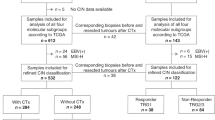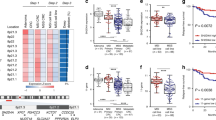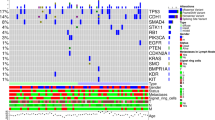Abstract
Recent studies claim a critical role for RUNX3 in gastric epithelial homeostasis. However, conflicting results exist regarding RUNX3 expression in the stomach and its potential role as a tumour-suppressor gene (TSG) in gastric carcinogenesis. Our aim was to evaluate the role of RUNX3 in early-onset gastric carcinomas (EOGCs). We analysed 41 EOGCs for RUNX3 aberrations using loss of heterozygosity (LOH), fluorescence in situ hybridization (FISH) and immunohistochemistry (IHC) analyses. LOH of markers flanking RUNX3 was relatively common, indicating that loss of the gene may play a role in gastric carcinogenesis. However, FISH analysis of selected cases and a panel of 14 gastric carcinoma-derived cell lines showed widespread presence of multiple copies of centromere 1. While RUNX3 copy numbers were generally equal to or fewer than those of centromere 1, at least two copies were present in almost all cells analysed. Accordingly, a subpopulation of tumour cells in 12/37 cases showed RUNX3 protein expression. However, expression was not detected in the adjacent nontumorous mucosa of any case. Together, these observations indicate that chromosome 1 aberrations occur frequently in EOGCs and are reflected in the LOH and IHC patterns found. Our findings refute a role for RUNX3 as a TSG in EOGCs.
This is a preview of subscription content, access via your institution
Access options
Subscribe to this journal
Receive 50 print issues and online access
$259.00 per year
only $5.18 per issue
Buy this article
- Purchase on Springer Link
- Instant access to full article PDF
Prices may be subject to local taxes which are calculated during checkout




Similar content being viewed by others
References
Bae SC and Choi JK . (2004). Oncogene, 23, 4336–4340.
Bangsow C, Rubins N, Glusman G, Bernstein Y, Negreanu V, Goldenberg D, Lotem J, Ben-Asher E, Lancet D, Levanon D and Groner Y . (2001). Gene, 279, 221–232.
Brenner O, Levanon D, Negreanu V, Golubkov O, Fainaru O, Woolf E and Groner Y . (2004). Proc. Natl. Acad. Sci. USA, 101, 16016–16021.
Carvalho R, Milne AN, van Rees BP, Caspers E, Cirnes L, Figueiredo C, Offerhaus GJ and Weterman MA . (2004). J. Pathol., 204, 75–83.
Corver WE, Ter Haar NT, Dreef EJ, Miranda NF, Prins FA, Jordanova ES, Cornelisse CJ and Fleuren GJ . (2005). J. Pathol., 206, 233–241.
Crawford SE, Stellmach V, Murphy-Ullrich JE, Ribeiro SM, Lawler J, Hynes RO, Boivin GP and Bouck N . (1998). Cell, 93, 1159–1170.
Ehlers M, Laule-Kilian K, Petter M, Aldrian CJ, Grueter B, Wurch A, Yoshida N, Watanabe T, Satake M and Steimle V . (2003). J. Immunol., 171, 3594–3604.
Etoh T, Kanai Y, Ushijima S, Nakagawa T, Nakanishi Y, Sasako M, Kitano S and Hirohashi S . (2004). Am. J. Pathol., 164, 689–699.
Fainaru O, Woolf E, Lotem J, Yarmus M, Brenner O, Goldenberg D, Negreanu V, Bernstein Y, Levanon D, Jung S and Groner Y . (2004). EMBO J., 23, 969–979.
Fernandez-Salguero PM, Ward JM, Sundberg JP and Gonzalez FJ . (1997). Vet. Pathol., 34, 605–614.
Fukamachi H and Ito K . (2004). Oncogene, 23, 4330–4335.
Hanai J, Chen LF, Kanno T, Ohtani-Fujita N, Kim WY, Guo WH, Imamura T, Ishidou Y, Fukuchi M, Shi MJ, Stavnezer J, Kawabata M, Miyazono K and Ito Y . (1999). J. Biol. Chem., 274, 31577–31582.
Haralambieva E, Kleiverda K, Mason DY, Schuuring E and Kluin PM . (2002). J. Pathol., 198, 163–170.
Igarashi J, Nimura Y, Fujimori M, Mihara M, Adachi W, Kageyama H and Nakagawara A . (2000). Jpn. J. Cancer Res., 91, 797–801.
Inoue K, Ozaki S, Shiga T, Ito K, Masuda T, Okado N, Iseda T, Kawaguchi S, Ogawa M, Bae SC, Yamashita N, Itohara S, Kudo N and Ito Y . (2002). Nat. Neurosci., 5, 946–954.
Ito Y and Miyazono K . (2003). Curr. Opin. Genet. Dev., 13, 43–47.
Jemal A, Clegg LX, Ward E, Ries LA, Wu X, Jamison PM, Wingo PA, Howe HL, Anderson RN and Edwards BK . (2004). Cancer, 101, 3–27.
Kokkola A, Monni O, Puolakkainen P, Nordling S, Haapiainen R, Kivilaakso E and Knuutila S . (1998). Cancer Genet. Cytogenet., 107, 32–36.
Komori T, Yagi H, Nomura S, Yamaguchi A, Sasaki K, Deguchi K, Shimizu Y, Bronson RT, Gao YH, Inada M, Sato M, Okamoto R, Kitamura Y, Yoshiki S and Kishimoto T . (1997). Cell, 89, 755–764.
Le XF, Groner Y, Kornblau SM, Gu Y, Hittelman WN, Levanon D, Mehta K, Arlinghaus RB and Chang KS . (1999). J. Biol. Chem., 274, 21651–21658.
Lee B, Thirunavukkarasu K, Zhou L, Pastore L, Baldini A, Hecht J, Geoffroy V, Ducy P and Karsenty G . (1997). Nat. Genet., 16, 307–310.
Levanon D, Bettoun D, Harris-Cerruti C, Woolf E, Negreanu V, Eilam R, Bernstein Y, Goldenberg D, Xiao C, Fliegauf M, Kremer E, Otto F, Brenner O, Lev-Tov A and Groner Y . (2002). EMBO J., 21, 3454–3463.
Levanon D, Brenner O, Negreanu V, Bettoun D, Woolf E, Eilam R, Lotem J, Gat U, Otto F, Speck N and Groner Y . (2001). Mech Dev., 109, 413–417.
Levanon D, Brenner O, Otto F and Groner Y . (2003). EMBO Rep., 4, 560–564.
Levanon D and Groner Y . (2004). Oncogene, 23, 4211–4219.
Li QL, Ito K, Sakakura C, Fukamachi H, Inoue K, Chi XZ, Lee KY, Nomura S, Lee CW, Han SB, Kim HM, Kim WJ, Yamamoto H, Yamashita N, Yano T, Ikeda T, Itohara S, Inazawa J, Abe T, Hagiwara A, Yamagishi H, Ooe A, Kaneda A, Sugimura T, Ushijima T, Bae SC and Ito Y . (2002). Cell, 109, 113–124.
Miki R, Okuda M, Oikawa T, Watanabe M, Ma Z, Matsumoto K, Iwata H and Inokuma H . (2004). J. Vet. Med. Sci., 66, 797–805.
Mundlos S, Otto F, Mundlos C, Mulliken JB, Aylsworth AS, Albright S, Lindhout D, Cole WG, Henn W, Knoll JH, Owen MJ, Mertelsmann R, Zabel BU and Olsen BR . (1997). Cell, 89, 773–779.
Okuda T, van Deursen J, Hiebert SW, Grosveld G and Downing JR . (1996). Cell, 84, 321–330.
Osaki M, Moriyama M, Adachi K, Nakada C, Takeda A, Inoue Y, Adachi H, Sato K, Oshimura M and Ito H . (2004). Eur. J. Clin. Invest., 34, 605–612.
Parkin DM, Pisani P and Ferlay J . (1999). Int. J. Cancer, 80, 827–841.
Sakakura C, Mori T, Sakabe T, Ariyama Y, Shinomiya T, Date K, Hagiwara A, Yamaguchi T, Takahashi T, Nakamura Y, Abe T and Inazawa J . (1999). Genes Chromosomes Cancer, 24, 299–305.
Sano T, Tsujino T, Yoshida K, Nakayama H, Haruma K, Ito H, Nakamura Y, Kajiyama G and Tahara E . (1991). Cancer Res., 51, 2926–2931.
Tanaka K, Yanoshita R, Konishi M, Oshimura M, Maeda Y, Mori T and Miyaki M . (1993). Oncogene, 8, 2253–2258.
Taniuchi I, Osato M, Egawa T, Sunshine MJ, Bae SC, Komori T, Ito Y and Littman DR . (2002). Cell, 111, 621–633.
Varis A, van Rees B, Weterman M, Ristimaki A, Offerhaus J and Knuutila S . (2003). Br. J. Cancer, 88, 1914–1919.
Woolf E, Xiao C, Fainaru O, Lotem J, Rosen D, Negreanu V, Bernstein Y, Goldenberg D, Brenner O, Berke G, Levanon D and Groner Y . (2003). Proc. Natl. Acad. Sci. USA, 100, 7731–7736.
Wu CW, Chen GD, Fann CS, Lee AF, Chi CW, Liu JM, Weier U and Chen JY . (2002). Genes Chromosomes Cancer, 35, 219–231.
Acknowledgements
We thank Dr D Levanon and Dr Y Groner (The Weizmann Institute of Science, Israel) for the invaluable assistance with RUNX3 IHC detection and analysis. We also thank Alex Musler, Folkert Morsink, Monique Oud and Esther Schilder (Academisch Medisch Centrum, The Netherlands) for the technical assistance provided. We further wish to acknowledge Dr S Akiyama (Nagoya University School of Medicine, Japan), Dr JN Primrose (Southampton General Hospital, UK), Dr H Yokozaki (Hiroshima University School of Medicine, Japan), Professor T Suzuki (Fukushima Medical College, Japan), Dr K Yanagihara (National Cancer Centre Research Institute, Japan), Dr M Manns (Medizinische Hochschule Hannover, Germany), Dr A van der Ende (Academisch Medisch Centrum, The Netherlands) and Professor M Sobrinho-Simões (Instituto de Patologia e Imunologia Molecular da Universidade do Porto, Portugal) for kindly providing the cell lines used in this study. Finally, we wish to thank Dr A Varis and Dr S Knuutila (both from the University of Helsinki, Finland) for their FISH expertise and their many helpful suggestions. This work was supported by the Vanderes Foundation, grant 68.
Author information
Authors and Affiliations
Corresponding author
Rights and permissions
About this article
Cite this article
Carvalho, R., Milne, A., Polak, M. et al. Exclusion of RUNX3 as a tumour-suppressor gene in early-onset gastric carcinomas. Oncogene 24, 8252–8258 (2005). https://doi.org/10.1038/sj.onc.1208963
Received:
Revised:
Accepted:
Published:
Issue Date:
DOI: https://doi.org/10.1038/sj.onc.1208963
Keywords
This article is cited by
-
Runt-Related Transcription Factor 3: Single Nucleotide Polymorphism rs760805, Gene Expression, and Methylation Status in Helicobacter pylori-Infected Patients for Determination of Gastric Cancer Risk
Journal of Gastrointestinal Cancer (2013)
-
Association between RUNX3 promoter methylation and gastric cancer: a meta-analysis
BMC Gastroenterology (2011)
-
Low frequency of HER2 amplification and overexpression in early onset gastric cancer
Cellular Oncology (2011)
-
Runx3 expression in gastrointestinal tract epithelium: resolving the controversy
Oncogene (2009)
-
IL-1B −31T>C promoter polymorphism is associated with gastric stump cancer but not with early onset or conventional gastric cancers
Virchows Archiv (2008)



